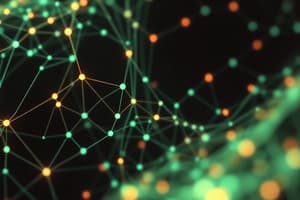Podcast
Questions and Answers
What is the main difference between supervised learning and unsupervised learning in machine learning?
What is the main difference between supervised learning and unsupervised learning in machine learning?
Supervised learning uses labeled data, while unsupervised learning does not use labeled data.
Name two techniques that fall under the category of machine learning discussed in the text.
Name two techniques that fall under the category of machine learning discussed in the text.
Supervised learning and unsupervised learning
What is the objective of unsupervised learning in machine learning?
What is the objective of unsupervised learning in machine learning?
To find patterns and relationships within data without using labeled data.
Provide an example of a supervised learning algorithm mentioned in the text.
Provide an example of a supervised learning algorithm mentioned in the text.
How does machine learning differ from traditional programming?
How does machine learning differ from traditional programming?
What is the main difference between supervised and unsupervised learning?
What is the main difference between supervised and unsupervised learning?
Explain the concept of transfer learning in machine learning.
Explain the concept of transfer learning in machine learning.
What are some examples of deep learning neural network architectures?
What are some examples of deep learning neural network architectures?
How do deep learning networks learn features from raw data?
How do deep learning networks learn features from raw data?
What is the role of clustering algorithms in unsupervised learning?
What is the role of clustering algorithms in unsupervised learning?
Flashcards are hidden until you start studying
Study Notes
Artificial Intelligence
This document is part of the AI research project and provides comprehensive information about artificial intelligence.
Introduction
Artificial Intelligence (AI) refers to the simulation of human intelligence processes by computer systems. These processes include learning, reasoning, problem-solving, perception, and language understanding. In recent years, there has been significant progress in AI technologies, particularly in machine learning algorithms. This research focuses on these aspects of AI.
Machine Learning
Machine learning is a subset of AI that involves training computer systems to learn from data without being explicitly programmed. It includes various techniques such as supervised learning, unsupervised learning, reinforcement learning, deep learning, and transfer learning.
Supervised Learning
Supervised learning is a type of machine learning where the model is trained using labeled data. That is, the data input contains both features and their corresponding output labels. Examples of supervised learning algorithms include regression models, decision trees, support vector machines (SVM), and neural networks.
Unsupervised Learning
Unsupervised learning, on the other hand, is a type of machine learning where the model is trained without any labeled data. Instead, the model learns to find patterns and relationships within the data itself. Examples of unsupervised learning algorithms include clustering algorithms, such as k-means and hierarchical clustering, and dimensionality reduction algorithms, such as principal component analysis (PCA).
Deep Learning
Deep learning is a subfield of machine learning that uses artificial neural networks with multiple layers to analyze and process data. These networks can automatically learn features from raw data, making them highly efficient for various tasks like image recognition, voice recognition, and natural language processing. Neural network architectures include convolutional neural networks (CNN), recurrent neural networks (RNN), and transformers.
Transfer Learning
Transfer learning is a technique used in machine learning where a pre-trained model is fine-tuned on a new dataset for a different task or domain. By leveraging the knowledge learned from the original task, the model achieves better performance on the target task with fewer training samples.
Conclusion
In conclusion, artificial intelligence, specifically machine learning, encompasses a wide range of techniques and algorithms designed to simulate human intelligence processes. From supervised learning to deep learning, these methods have revolutionized how computers handle and interpret complex data. As we continue to advance our understanding of AI, the applications will become even more diverse and impactful across industries.
Studying That Suits You
Use AI to generate personalized quizzes and flashcards to suit your learning preferences.




